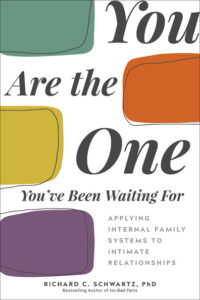In the Internal Family Systems model, the practice of speaking for, rather than from, parts when they are triggered is an important aspect of Self-leadership. When people receive a message from you, it has two components: the content (the actual words) and the energy behind the words. When your protective parts are upset and speak directly to another person, invariably they will trigger parts in the other. When, on the other hand, you listen to your protectors and then speak for them, from your Self, the message is received in a very different way, even if you use the same words that your parts are saying. Your words lose their judgmental sting or their off-putting desperation and coerciveness. Instead, your respect and compassion for the other person will be heard in addition to the courage of your convictions.
Self energy has a soothing effect on any parts it touches, whether they are in you or in another person. When your parts trust that you will speak for them, they feel less driven to take over and explode at people. What they really want is to have a voice—to be listened to by you and to have their position represented to others.
Practice: SELF-LEADERSHIP AS A WAY OF INTERACTING IN A CONFLICT
These practices—remaining the “I” in the storm or the empty vessel, and speaking for rather than from your parts—can be combined into a general way of relating as a couple when you have conflict. When you begin to fight, each of you can try the following:
- Pause
- Focus inside and find the parts that are triggered
- Ask those parts to relax and let you speak for them
- Tell your partner about what you found inside (speak for your parts), and
- Listen to your partner from your open-hearted Self
When a couple is embattled and each focuses inside, as in step 2, usually they only hear from their protectors. If it feels safe enough, moving an extra step toward vulnerability can reap big rewards. That step involves staying inside long enough to learn about the exiles that your protectors are guarding, and then telling your partner about these vulnerable parts. In most cases, when one partner has the courage to reveal the vulnerability that drives their protectiveness, the atmosphere immediately softens and the couple shifts toward Self-to-Self communication.
This is an excerpt from You Are the One You’ve Been Waiting For: Applying Internal Family Systems to Intimate Relationships by Richard C. Schwartz, PhD.

Learn More
Amazon | Barnes & Noble | Bookshop | Sounds True







